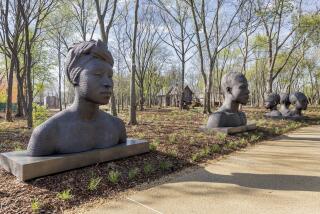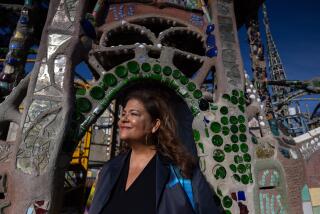National Mall reflects magnificence and neglect
WASHINGTON — Millions will cram shoulder to shoulder to watch Barack Obama take the oath of office this month as the nation’s 44th president, another indelible snapshot of American democracy in full display on the National Mall.
But beyond the reach of the camera’s lens, the historic promenade that stretches from the Lincoln Memorial to the U.S. Capitol -- the place often called America’s Front Yard -- is itself a monument to neglect.
Patches of the once-lush lawn have been trampled to dust. Half of the underground sprinkler system doesn’t work. The sea wall around the Jefferson Memorial is sinking, and lately, wildlife is dying in the unfiltered waterways.
Bill Line, spokesman for the National Park Service, which maintains the Mall, likes to say it has been “loved to death,” an American treasure battered by 25 million visitors a year -- more than Yosemite and Yellowstone national parks and the Grand Canyon combined. As the crowds have grown, the budget has shrunk, and with $350 million in overdue care, the park service cannot maintain a standard that befits what many consider a national jewel.
“This is America. This is how we show ourselves to the rest of the world,” said Line, 51, an encyclopedia of Mall trivia in pine-tree-green pants and a razor-brimmed hat.
If 700 acres in the shape of a kite can tell the story of a nation, the Mall is the embodiment of America. Its major monuments honor three wars and four presidents. It hosts the July 4 celebrations, contains war protests and oversees the nation’s important conversations, including immigration, abortion and civil rights. It reminds us of where we came from and who we are.
Today, though, the Mall is a study in contrasts, glorious and broken all at once. The story of its place in history and its sad decline is best understood on foot, and so Line, who bikes past the monuments every day and walks the grounds every chance he gets, agrees to show us 23 of the nation’s most treasured and timeworn blocks.
A cold December wind cuts sideways as Barry Porter looks out across the historic expanse for the first time in 30 years. He used to play hooky here, ditching junior high to check out the dinosaurs at the Natural History Museum or marveling at Abe Lincoln’s big concrete feet.
This isn’t the way he remembers it. Straight ahead is the elegant pool that is supposed to reflect the Washington Monument. It sometimes still does, when the water isn’t fouled by algae and goose droppings. The grass borders around it are pitted and bald. A plastic grocery bag slaps at one edge.
“It just looks beaten down. This grass used to be so green,” says a disappointed Porter, 56, a respiratory therapist who now lives in North Carolina.
The Lincoln Memorial towers behind us as visitors traipse its broad steps, mostly unaware of the history that has transpired here. Halfway down is the spot where Martin Luther King Jr. delivered his “I Have a Dream” speech in the summer of 1963. Only yards from there, 10 summers later, a frustrated Richard Nixon paid a surprise predawn visit to antiwar protesters camped out on the steps. And at the foot of the staircase is where African American contralto Marian Anderson sang at the invitation of Franklin and Eleanor Roosevelt on Easter Sunday in 1939, after the Daughters of the American Revolution barred her performance at Constitution Hall.
Dead ahead two miles, the U.S. Capitol dome gleams at the end of an unbroken vista lined with American elms where the iconic monuments unfold -- Lincoln, Roosevelt, Jefferson, Washington, Korea, Vietnam, World War II. This cherished view, inspired by the wide streets of Paris, is protected by an act of Congress. But lately Congress has been blind to the Mall’s poverty. The park service budget has dwindled to $31 million, even as more attractions bring relentless wear and tear. A $100-million appropriation for repairs failed to pass last year.
“We welcome everybody, but it is reasonable to expect that 25 million visitors -- 50 million feet -- are going to take some sort of a toll. The challenge is how do we welcome those visitors and still keep it looking as nice as it can,” Line says.
The Vietnam Veterans Memorial alone draws 4 million people yearly, a moving chronicle of casualties etched in polished black granite. Ron Brooks, 63, of Atlanta, a Vietnam veteran making his first visit here, has just found the names of two of his buddies.
“It’s beautiful,” Brooks says, reaching for words to describe his emotions, his eyes still wet.
The wall sits in Constitution Gardens with a lovely little lake. It’s a peaceful setting, except, like most of the Mall’s waterways, the lake has no filtration system and smells so fetid in the hot months that families stay away. Last summer, dozens of dead fish floated up near a memorial to the 56 signers of the Declaration of Independence.
We continue down the Mall’s pebbled path toward the World War II Memorial, which opened four years ago and draws as many as 60,000 visitors a day in peak season, enough to fill Dodger Stadium. But no money was allotted for upkeep, not even to empty the trash.
Just south and slightly off the path stands the bronzed statue of Thomas Jefferson gazing across a churning Tidal Basin. This is one of the city’s prettiest spots, where historic cherry trees bloom magnificently every spring. It’s where one night in 1974 a stripper known as Fanne Foxe leaped from Arkansas Rep. Wilbur Mills’ limo and into the water, ending his career and improving hers.
Today, a deteriorating sea wall around the memorial has sunk 9 inches in 18 months; the water breaches the wall twice a day at high tide. Metal barriers block off sections of a crumbling walkway to keep tourists from falling in.
We head back over to the Mall proper, at 15th Street, to the rocket-shaped Washington Monument, one of the city’s most recognizable landmarks. There used to be flower beds near here, commissioned by Lady Bird Johnson. The park service tore them out years ago rather than watch them go to weeds.
The lawn that stretches 14 blocks from here to the Capitol serves as America’s playground and cultural echo chamber, the site of fireworks and first-lady book fairs and where Jane Fonda protested an unpopular war. But the stakes from all the festival tents have punctured the underground sprinkler system; maintenance crews now drag out water cannons. At the moment, half of it is cordoned off for reseeding, a futile effort. The grass won’t have time to grow back before the inauguration crowds descend.
A man stops to ask Line for directions to the National Gallery of Art. “Right over there,” he points. The most popular Smithsonian museums flank this end of the Mall, housing Julia Child’s kitchen, Dorothy’s ruby slippers and Lindbergh’s plane. Orange cones surround a pool on the pathway where an underground pipe sprung a leak several weeks ago and has yet to be fixed.
We cross 4th Street, within shouting distance of the Capitol now. Someone has plastered “End the Fed” signs on every available surface. Their removal is another chore on the park service’s to-do list. Crews are busy constructing the inaugural viewing stands on the West Lawn. This is where 1.2 million came to watch as Lyndon B. Johnson promised a still-grieving nation an end to tyranny and misery in 1965.
In another stagnant reflecting pond just below, dozens of ducklings died last summer from avian botulism.
The Capitol, meanwhile, glistens with fresh paint and manicured lawns. There is a mathematical explanation to the disparity: Congress employs 2,000 maintenance workers to tend 300 acres where 535 lawmakers and their staffs come to work. The park service employs 300 workers to care for 700 acres where 25 million visitors come to play. “You keep your lawn better than we keep this,” fumes Rep. Eleanor Holmes Norton, the District of Columbia’s famously outspoken but nonvoting delegate, who for years has pressed for Mall repairs.
Though the 2 million people expected to attend Obama’s Jan. 20 inauguration will do more damage than the park service can mitigate, advocates hope the historic ceremony will draw public attention to its little-noticed plight. The fact is, the Mall’s magnificence still overshadows its decay. But for how long?
“We would call it a disgrace,” said Caroline Cunningham, president of the Trust for the National Mall, a year-old group working with the park service to raise half a billion dollars for a face-lift. There are plans to fix the light posts, upgrade the waterways and shore up the sea wall -- if the money can be raised.
The Mall is probably its own greatest advocate; few who see it are unmoved by its majesty. Some, like Bentley Smith of Philadelphia, a first-time visitor, would even pay higher taxes to restore it, a sentiment seldom heard in Washington.
It has something to do with national pride, like sending the queen out in public in a frayed coat. Nobody wants that.
“This is the face of our country, and we need to make it pretty again,” Smith, 49, says, back at the Lincoln Memorial looking out at America’s tired front yard.
“Is this the best foot we can put forward?”
--
--
latimes.com
/columnone
Previous Column One articles are available online.
More to Read
Sign up for Essential California
The most important California stories and recommendations in your inbox every morning.
You may occasionally receive promotional content from the Los Angeles Times.










